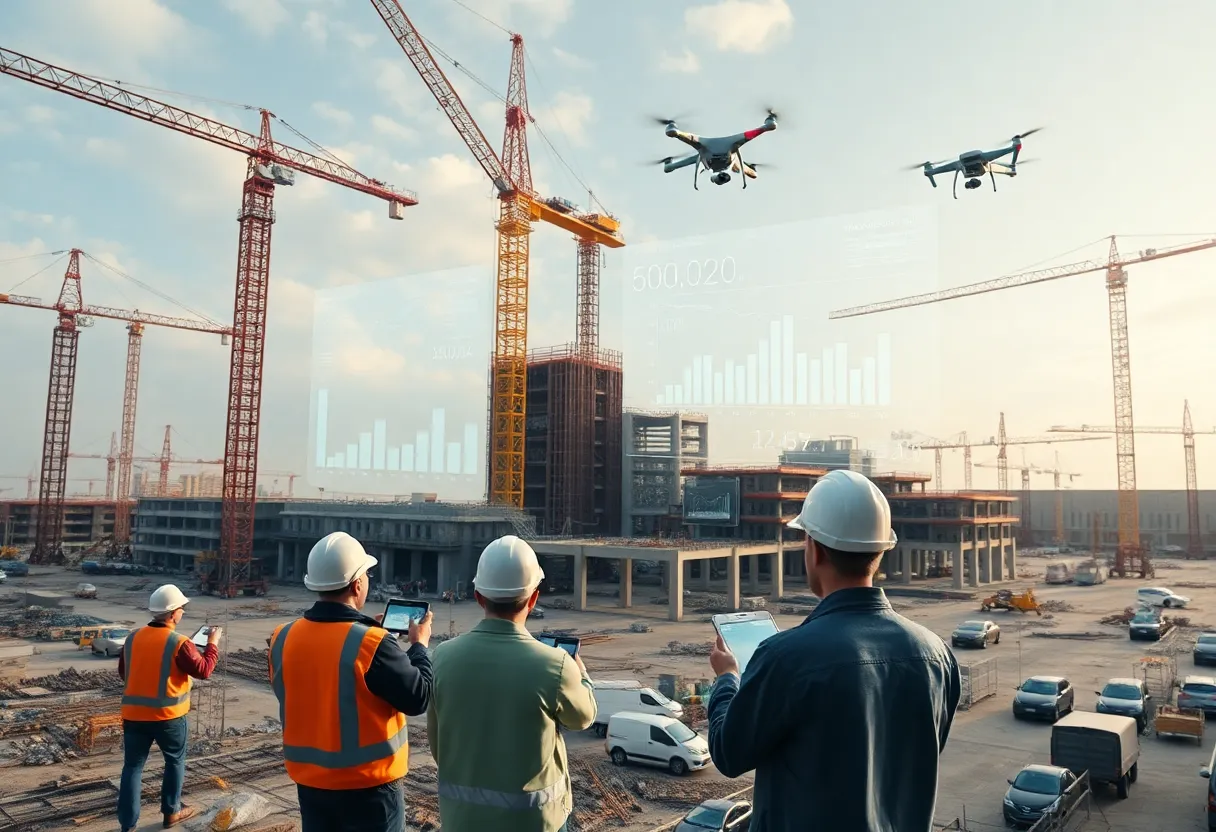Global, September 10, 2025
News Summary
Global demand for construction project management software is accelerating as owners, contractors and programs seek unified platforms for scheduling, budgeting, document control, resource tracking, collaboration and reporting. Cloud and mobile access, integration with BIM, AI, IoT and drones, and rising infrastructure investment are expanding use across complex, multi-project programs. Reported benefits include faster review cycles, fewer overruns, improved safety and more complete digital workflows on large projects. Adoption barriers remain for smaller firms due to cost, change management, legacy systems and connectivity, but those pairing rollouts with training see the biggest gains.
Global Construction Project Management Software Market Heads Toward USD 7.40 Billion by 2030
The market for construction project management software, which helps oversee projects from start to finish, was valued at USD 4.07 billion in 2024 and is forecast to grow to USD 7.40 billion by 2030. The growth corridor is described as a compound annual growth rate (CAGR) of 10.48% from 2024 to 2030, signaling a steady shift toward digital tools across the construction sector. These platforms are designed to manage project lifecycles, offering core functions such as scheduling, budgeting, document control, resource management, real-time collaboration, and reporting.
At heart, construction project management software pulls data from multiple departments into a single digital ecosystem. This centralization is intended to improve coordination, boost productivity, reduce cost overruns, and help teams stay compliant with industry standards. The trajectory of growth is tied to the increasing complexity and scale of modern projects, especially in areas like infrastructure, commercial development, and industrial construction.
Two broad forces are driving adoption: a move toward cloud-based and mobile-enabled solutions that enable remote collaboration and real-time updates, and a push to integrate with other advanced technologies. The report highlights that integration with BIM, AI, IoT, and drones is enabling smarter, more agile project execution. As stakeholders shift away from manual, siloed tools toward centralized digital ecosystems, the value proposition centers on better decision-making and greater transparency.
Geographically, the report notes a strong emphasis on regions with high infrastructure investments, including Asia Pacific, Africa, and the Middle East. Governments and organizations are funding large-scale development across transportation, energy, housing, and utilities, which in turn sustains demand for digital tools that can streamline planning, risk management, and interdepartmental coordination. A key market driver is the surge in global infrastructure investments, supported by ongoing public and private capital programs.
In practical terms, these platforms provide a centralized hub for timelines, procurement, resource distribution, and compliance, enabling teams to work off the same data and dashboards. The anticipated benefits include mitigating risks, improving transparency, and aligning multiple project collaborators across disciplines and locations. Industry forecasts also point to a broader shift in how projects are delivered, with digital tools becoming a standard part of the construction workflow rather than an optional add-on.
While market growth looks robust, challenges remain. A notable hurdle is the resistance to digital adoption within traditional construction ecosystems. Many small and medium-sized firms still rely on outdated tools, paper-based tracking, and manual processes. Reasons cited for reluctance include high implementation costs, software complexity, and disruption to familiar workflows. Gaps in digital literacy, especially among senior professionals, and a lack of structured change management within organizations also hinder uptake. Additional deployment issues include integration with legacy systems and limited internet access at remote job sites, which can complicate rollout. All these factors contribute to uneven technological maturity across the sector, slowing adoption and limiting realized benefits.
Despite these barriers, the market is advancing as adoption broadens to include digital twins, enhanced data analytics, machine learning, and real-time collaboration. The trend toward integrating with BIM for better visualization and clash detection, AI for risk forecasting, and IoT for equipment tracking and safety monitoring is redefining what project management software can do. When cloud platforms are paired with these technologies, stakeholders can collaborate in real time, reduce downtime, improve safety compliance, and make more transparent decisions.
Beyond the market numbers, practical deployments illustrate how digital tools reshape project delivery. In Ireland, a prominent contractor has moved toward a lifecycle focus and public–private partnerships (PPPs) that span asset operation for up to 25 years. Digital workflows have replaced much of the paper-based data collection, with a move toward digital housekeeping and integration of data across models and asset metadata. In another large-scale program, a major airport authority is using a unified cloud platform to manage a multi-project investment program, onboarding hundreds of suppliers to a connected data environment, and reporting faster review cycles and issue resolutions. These examples reflect a broader industry pattern: organizations increasingly adopt a data-then-action approach to manage complex, high-budget initiatives more efficiently and with greater control over quality and safety outcomes.
Overall, the emerging market picture points to a sustained move toward centralized, cloud-enabled project management platforms that connect BIM, AI, IoT, and other technologies. The outcome is expected to be more predictable project performance, lower risk, and clearer accountability across teams, suppliers, and customers as the construction sector continues its digital transformation.
Key drivers and market dynamics
Key drivers: increasing project complexity and scale; rising demand across infrastructure, commercial, and industrial sectors; and a broad shift to cloud-enabled, mobile-ready tools that support remote work. Technology integration with BIM, AI, IoT, and drones is redefining how projects are planned, tracked, and executed.
Geographic emphasis: regions with heavy infrastructure programs, notably Asia Pacific, Africa, and the Middle East, are highlighted as important growth areas due to government and private sector investments.
Adoption themes: organisations are moving from isolated tools to centralized digital ecosystems, with a focus on risk management, transparency, and cross-team coordination.
Challenges and risks to adoption
Resistance to digital adoption remains the biggest hurdle. Smaller firms may face cost concerns, software complexity, and disruption to established workflows. Gaps in digital literacy, especially among senior professionals, and the lack of structured change management programs further slow uptake. Legacy systems can complicate integration, and remote sites with limited connectivity can hinder deployment and real-time collaboration. The result is an uneven level of technological maturity across the construction ecosystem, which can dampen potential benefits from digital tools.
Case-style implications: digital adoption in action
In one ongoing adoption, digital twins and integrated data models are used to de-risk projects and simulate construction scenarios, driving improved planning and coordination. A second example shows how a major infrastructure program leverages BIM and cloud platforms to reduce paper storage and streamline data exchange, while enabling project managers to identify and respond to issues more quickly. These real-world deployments illustrate how digital tools can deliver measurable gains in on-site quality, safety, and efficiency when combined with disciplined change management and staff training.
Table: Key features of the post
| Feature | Description |
|---|---|
| Market size (2024) | USD 4.07 billion |
| Forecast (2030) | USD 7.40 billion |
| CAGR (2024–2030) | 10.48% |
| Core functionalities | Scheduling, budgeting, document control, resource management, real-time collaboration, reporting |
| Key drivers | Project complexity, infrastructure investments, cloud/mobile adoption, BIM/AI/IoT/drones integration |
| Geographic emphasis | Asia Pacific, Africa, Middle East |
| Adoption challenges | Cost, complexity, disruption to workflows, digital literacy gaps, legacy systems, remote site connectivity |
FAQ
Glossary of key terms
- Centralized digital ecosystem: a unified software environment that connects multiple project data sources for real-time collaboration.
- Digital twin: a dynamic, virtual representation of a physical asset or project used to simulate performance and outcomes.
- BIM (Building Information Modeling): a process and set of tools for creating and managing the visual/functional representation of a project.
- Construction IQ: a machine-learning capability that analyzes construction data to identify high-risk issues.
Deeper Dive: News & Info About This Topic
Additional Resources
- GlobeNewswire: Construction Project Management Software Market Analysis Report 2025
- Wikipedia: Construction management
- Autodesk: BAM Ireland — AI in construction (customer story)
- Google Search: BAM Ireland AI in construction
- ENR: Dublin Airport takes off into construction cloud & digital twin
- Google Scholar: digital twin construction airport
- Business Alabama: Command Alkon provides the software to help its clients manage heavy loads
- Encyclopedia Britannica: construction software
- SiliconRepublic: ConX — Houzz acquisition / construction tech startup
- Google News: ConX Houzz acquisition construction tech





